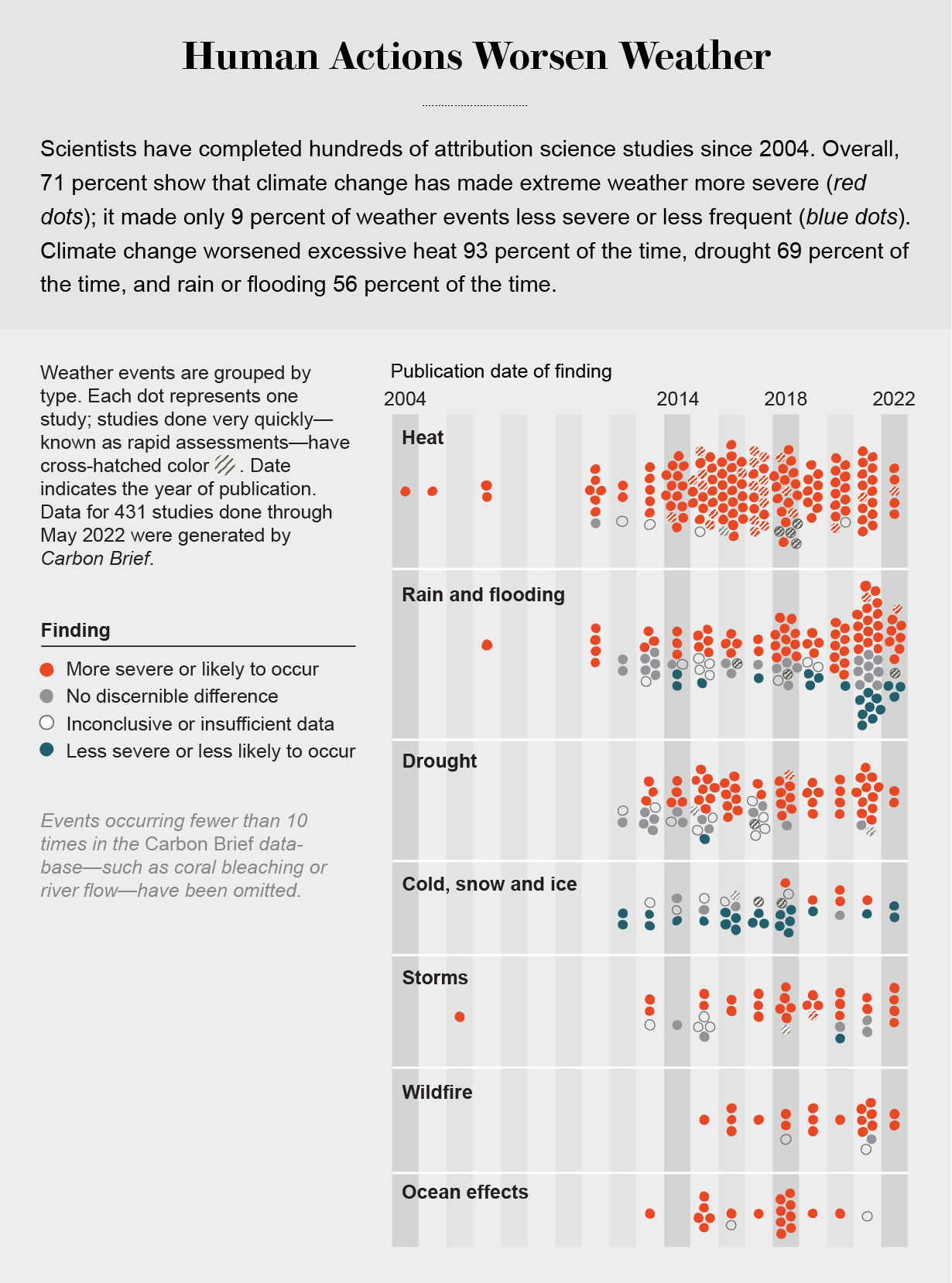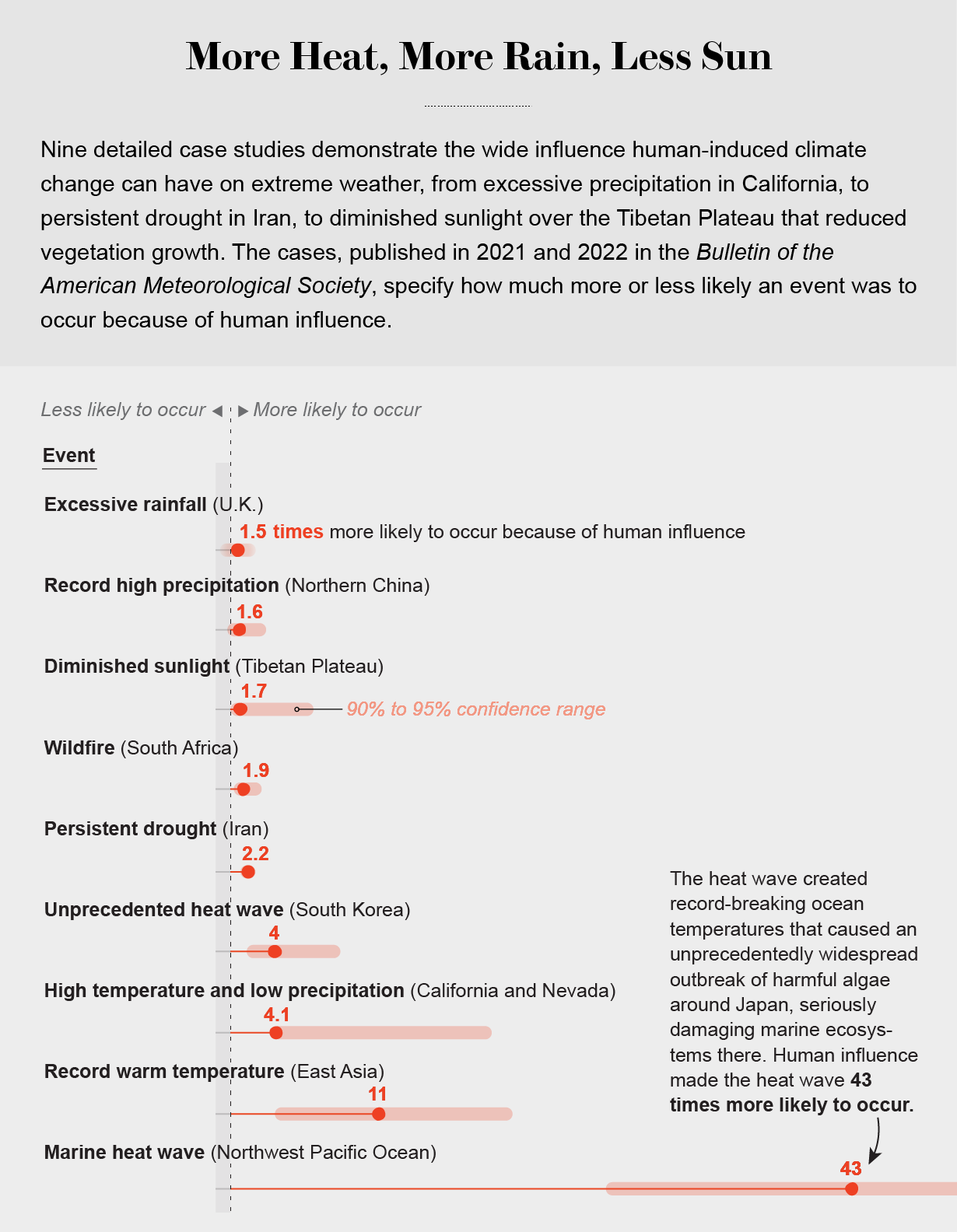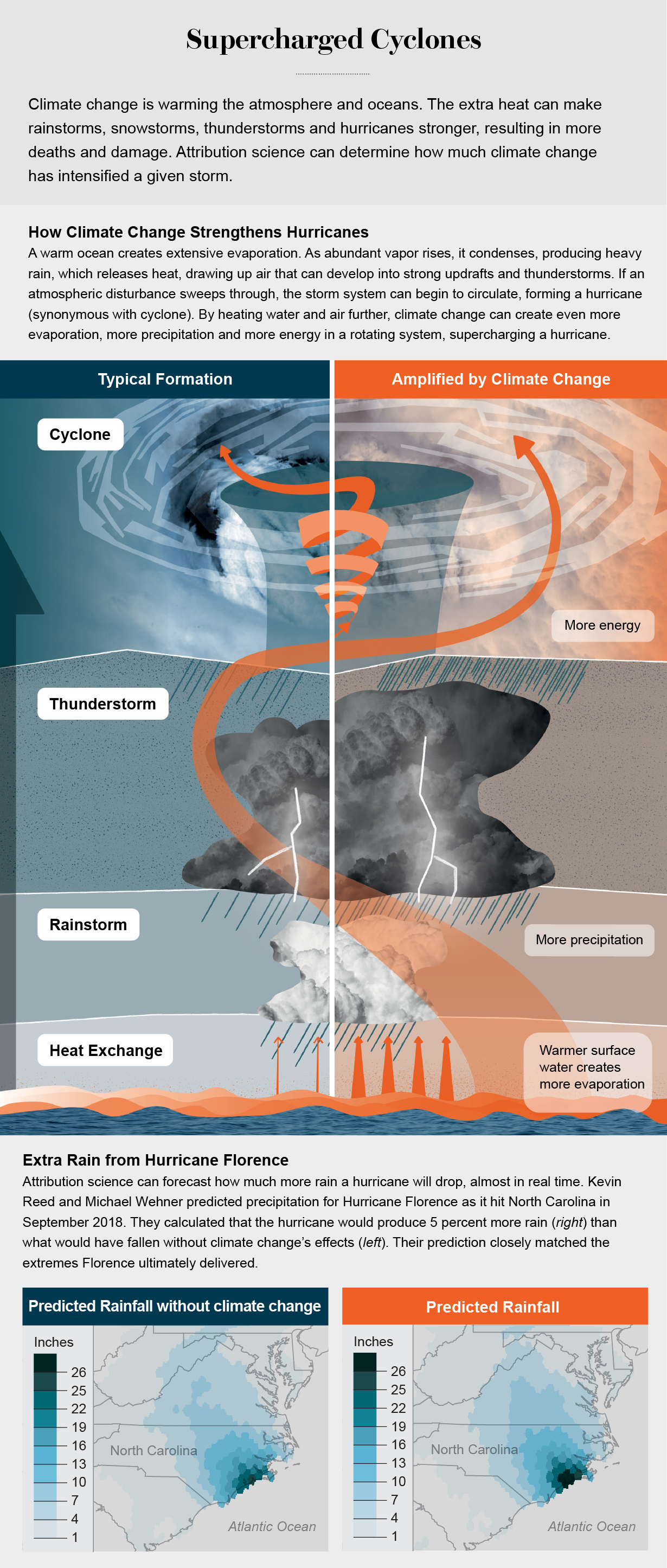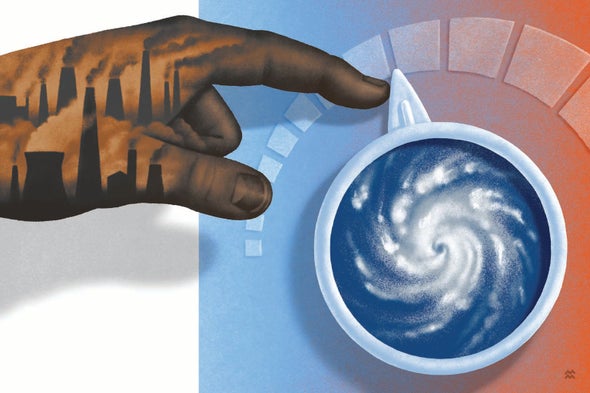Last November the spring weather in South America jumped from cold to searing. Usually at that time of year people would have been holding backyard barbecues, or asados, in the lingering evening light. But on December 7 the temperature in northern Argentina, near the borders of Bolivia and Paraguay, hit 115 degrees Fahrenheit, making it one of the hottest places on Earth. The heat exacerbated a three-year drought, baking the soil and shriveling vast wheat crops before harvest.
As the Argentine government restricted wheat exports and warned people to stay indoors, a small team of scientists from around the globe logged on to Zoom. They belonged to the World Weather Attribution (WWA) group, a collaboration of climate researchers that Friederike Otto and Geert Jan van Oldenborgh formed in 2014 to address a persistent, nagging question: Is climate change making extreme weather worse and, if so, by how much? The group's ambitious goal is to provide straight answers almost as quickly as disasters strike—for the public, the media and policy makers, as well as for emergency managers and urban planners trying to understand how to prepare for the next severe event.
Just over a week after a 2021 heat dome began baking the U.S. Pacific Northwest, for example, the team released a careful and comprehensive evaluation built on previous science. It concluded that the record-breaking circumstances would have been almost impossible without human-caused climate change, noting that the temperatures “were so extreme that they lie far outside the range of historically observed temperatures.” When swaths of India and Pakistan suffered heat dangerous to human life in the spring of 2022, the team estimated that climate change made the heat wave hotter and more likely. And when large parts of Pakistan flooded last summer, the group found that climate change could have increased the rainfall by as much as 50 percent.
This speed and certainty are huge advances in extreme weather analysis from a decade ago, when many scientists were reluctant to say how climate change might have contributed to individual events. The field “has completely changed,” Otto told me from her office—walls covered with maps of the world—at the University of Oxford, where she is a professor of global climate science. Fredi, as colleagues call her, was born in Germany and is now a U.K. citizen. When she describes the history of attribution science, she is blunt: “At the beginning people were saying, ‘You can't do this; the models aren't good enough.'” Otto adds, “We now know how to do this.” Attributions in 2014 were difficult and slow, in part because it can take more than a year for a scientific study to make it through peer review. To address that lag, the WWA developed a peer-reviewed methodology to quickly conduct this kind of research and release the findings directly to the public.
A decade ago the Intergovernmental Panel on Climate Change said attribution science was not yet “fit for purpose.” In contrast, a 2021 IPCC report called attribution science “robust.” The growing ability to say decisively just how much climate change is to blame could have implications for everything from insurance claims and court cases to international negotiations over which nations should pay for climate adaptation. Otto also hopes the WWA's reports will show governments why it is vital to reduce emissions. And so last December, as high temperatures roasted Argentina, Bolivia and Paraguay, Otto and the rest of the WWA got to work.
Rising Confidence
One of the first climate attribution studies to be widely cited by other scientists was published in 2004 in Nature. It came out about a year and a half after Europe's hottest summer in centuries, when crops failed, glaciers in the Alps shrank by as much as 10 percent and more than 30,000 people died. The lead author, Peter A. Stott, a climate scientist at the Met Office Hadley Center for Climate Science and Services in England, concluded that human influence had at least doubled the chance of the record-breaking heat wave. At the time, says Stephanie Herring, a climate scientist at the National Oceanic and Atmospheric Administration, the question was considered “super in the weeds,” intriguing primarily to researchers who enjoyed debating statistical probability and the atmosphere's physical dynamics. When she began publishing an annual report on extreme events for the American Meteorological Society in 2012, “none of us expected there to be the level of public interest that this field of research ended up gaining.”
Interest grew after Superstorm Sandy hit New York City and New Jersey in October 2012. Everyone wanted to know how the storm could have stayed so strong so far north. A report released months later noted that an excessive amount of Arctic sea ice had melted earlier that year, creating large regions of open water that absorbed heat from the sun, possibly contributing to Sandy's fury—although the links were still described as just one plausible theory. Scientists tend to be conservative, prone to underestimating impacts, says Kevin Trenberth, a distinguished scholar at the National Center for Atmospheric Research. Most researchers were still reluctant to discuss how climate change might have influenced a particular storm.
Advances in technology have made it easier to isolate climate's role. In the early 2000s few institutions had high-performance computing systems capable of running data-heavy climate models. Today, with cloud services, researchers can do this work at home from a laptop. It's easier to combine models and run them multiple times, increasing confidence in the results. The accuracy of models has also improved, and their resolution has become much more granular, making them better at providing more precise information about specific locations.
As the field grew, two methods developed. One, known as probabilistic event attribution, is used to estimate how much human behavior has contributed to the odds of a certain kind of event occurring, such as a heat wave. Scientists compare models of extreme weather dynamics with simulations of a world in which climate change is not happening, revealing whether factors such as increased emissions made an event more likely. The WWA's first study, for example, compared temperatures in five French cities during a 2015 heat wave with those from summers in the first half of the 1900s, revealing that climate change quadrupled the chances of the heat wave occurring.

In contrast, the conditional or “storyline” approach asks questions about specific incidents: Did climate change make the rainfall of a particular storm more intense? This method emphasizes thermodynamic changes, such as warmer air holding more water vapor.
Trenberth, an early supporter of the storyline approach, says the scientific debate over the two methodologies was initially acrimonious. When a 2014 study by Martin Hoerling of NOAA, done after intense flooding in Boulder, Colo., found that climate change had not increased the chance of heavy rain in the region, Trenberth and his colleagues challenged the results. They said the study didn't consider warm sea-surface temperatures in Mexico, which Trenberth claimed added significant moisture to the atmosphere, increasing the total precipitation. Hoerling responded that Trenberth was oversimplifying. The whole debate played out in a reported news article in Nature.
Over time both camps realized the approaches can complement each other. “In an ideal world, you would always do both,” Otto says. “They are looking at the problem in different ways.” Both methods have the potential to provide important information about relative risk, says Elisabeth Lloyd, a fellow of the American Academy of Arts and Sciences. Together, the analyses could tell policy makers whether roads and bridges will have to withstand heavier rainfall and could inform emergency managers about how frequently in the future they might have to control access to those roads and bridges because of storms.
The field made further headway in 2017 after Hurricane Harvey stalled for days over the greater Houston region, dumping as much as 60 inches of rain in places, far exceeding previous records. Trenberth found that superwarm ocean water in the Gulf of Mexico created greater evaporation than normal, leading directly to excessive precipitation. A separate analysis by Otto and her colleagues indicated that climate change had added 15 percent more rainfall. Trenberth wrote that governments in regions prone to hurricanes would need to plan for greater flooding, including making upgrades to evacuation routes, building codes and power grids.
That was exactly the kind of social and political prescription that generates biting criticism that climate scientists should “stay in their lane”—do research but keep quiet about its implications. Otto says she has at times been faulted for being too political. “But there isn't such a thing as a neutral scientist,” she says. “The questions we ask are always influenced by our values, by who is funding us, by where we live. Making it transparent is what makes good science—not pretending it's not happening.”
The Argentina Challenge
When the WWA began, it analyzed just a few events a year. Now it meets online to discuss disasters almost every week. The small team has to prioritize which incidents it thinks merit investigation. Many of its scientists are volunteering their time, squeezing in work between research or teaching jobs and other responsibilities.
To decide which disasters to study, the scientists assess potential humanitarian impacts using criteria the WWA has developed for different kinds of events. For heat waves, factors include related deaths and whether the affected area is densely populated or particularly vulnerable. The WWA tends to take on incidents that harm many people, but it also strives to cover diverse regions. “We don't want to do only events in the Global North because that's where we happen to work,” says Sarah Kew, a climate scientist at the Royal Netherlands Meteorological Institute. Breaking new scientific ground is a factor, too, Otto says. The WWA decided not to study the Arctic blast that subjected millions of people in the U.S. to dangerously cold temperatures over the 2022 Christmas and New Year's holidays, because it had previously studied similar cold snaps in North America and didn't expect to find anything new.

The South American heat wave caught the team's attention because it met several of the WWA's criteria for heat waves: record-breaking temperatures occurring in very early summer in a vulnerable area. Although the first video conference to discuss it in late November 2022 offered some windows into the researchers' lives—Madrid's sunshine, London's gloom—the meeting began without small talk. “We have the Argentine heat wave that expanded north,” said Maja Vahlberg, who works with the Red Cross Red Crescent Climate Center. “Is it La Niña–related?” Otto asked, referring to a circulation pattern in the Pacific Ocean that can make heat waves more likely in the Argentina region. In a fast-paced conversation, the team decided to reach out to scientists in South America for detailed information and quickly scheduled another meeting for early December. Twelve minutes after the call began, everyone logged off.
The WWA collaborates with local experts whenever possible, counting on them to know which data sets have the most comprehensive information about a region or how to best gather meteorological data there. At the meeting in early December, Juan Antonio Rivera, a climate scientist at the Argentine Institute of Snow Research, Glaciology and Environmental Sciences, joined the Zoom collage from his office in Mendoza. The recent drought had affected northern Argentina, southern Brazil, Uruguay and Paraguay, he told the group, but large parts of those regions lack a dense network of weather stations. One of the first tasks would be to see what data were available for analysis of how the drought intensified over time. He could help the group dig into information that might not be easy to find for people living in Europe or that might not be accessible to them because of language barriers.
The scientists on the call—some in the Netherlands wearing sweaters, others sweating in the Chilean sun—talked through options for untangling the heat wave's influence from the drought. “Every time we have a heat wave, the drought gets worse,” said Anna Sörensson, a researcher at the French-Argentinean Institute for the Study of Climate and Its Impacts, who lives in Buenos Aires. Low water levels in rivers had disrupted an important agricultural export route, along with hydropower generation, she said. A transportation union had even contacted her for advice on designing new boats to work in the lower rivers.
The team had to define each event in a productive way. For every attribution study, Otto told me later, they need to find out what they can measure. For heat waves, the group looks for temperatures over a certain threshold for a given period. Droughts are more complex because they can be characterized in many ways—by lack of rain, by soil moisture or by levels of surface water. A definition may require multiple measurements. “If you have very high temperatures, you have very high evaporation, so you have low stream flow, which has huge economic impacts; you can't capture that just looking at the rainfall,” Otto said.
Otto asked the team whether it could do something fast and meaningful based on just temperature and precipitation. The group bandied the options around: Heat waves are fairly straightforward to analyze because many have been studied and linked to climate change. But some WWA members advocated for a larger, slower analysis of the drought. Finally, one member asked, “Is there an option of doing both?”
Rivera impressed on the others just how striking the temperatures had been in his homeland. “November was the warmest November recorded in Argentina,” he said. The group's enthusiasm swiftly built for doing a heat study quickly and giving the more complex drought research the time it required. “It's something we haven't done before—one study but published in two parts,” Otto mused. Before people winked out of the video meeting and returned to their physical realities, they parceled out tasks they each would pursue offline.
Within a few weeks the scientists used five different sets of computer models to compare the characteristics of climate today with preindustrial conditions. They focused on the hottest one-week period in early December and found that climate change made the heat wave 60 times more likely to happen. Temperatures in Argentina were probably about 2.5 degrees F hotter than they otherwise would have been. Previous research suggested that amount of difference could have increased the risk of heat-related deaths by more than 5.7 percent. The WWA released its findings late in December as yet another swelter swept over Argentina. “It is noteworthy that these record temperatures occurred before the beginning of the austral summer season, making them particularly exceptional,” the group wrote.
As the team turned to its drought study, power in parts of Buenos Aires failed. Wildfires broke out across northern Argentina and neighboring Chile.
“What turns any weather event into a disaster is vulnerability and exposure,” Otto says. Heat records alone don't capture how people are affected. If you don't look at scientific research and disaster response together, she says, “you will just not understand what climate change means.” Latin America, for example, has high levels of inequality, with marginalized communities that are more vulnerable to health consequences from extreme weather. Rivera recounted a meeting where desperate farmers knelt on the dry soil and prayed for rain.

Although Argentina's plight largely failed to make headlines north of the equator, its impact will be felt globally. The country is a major wheat exporter; a trade group estimates half of the wheat crop will be lost in 2023 because of the drought, and all crop losses could amount to $10 billion. Analysts warned that the country's agricultural failures would further increase food prices around the world.
The WWA stands out in the climate research sphere for its willingness to directly address social factors. Otto points to a 2022 study that the WWA conducted in Africa's Sahel region, which she says had basically nothing to do with the weather. The region's economy relies on rain to irrigate crops and sustain herds, but in 2021 a delayed rainy season caused cascading food insecurity. “Even small shifts in rainfall,” the WWA wrote, “impact the already limited food supply.” Because of large uncertainties in data sets, the team could not determine whether there was a climate signal in the rainfall shifts, but it warned that the region is “vulnerable to future impacts of climate change on global breadbaskets.”
Life and Death
Even as attribution science improves, some experts argue that climate scientists are still underselling their conclusions—an important factor as the field begins to move out of academic circles and into public proceedings such as court cases. A related issue is that evidence introduced in court often lags the latest science. In a 2021 Nature Climate Change study, Otto and her collaborators examined 73 climate lawsuits worldwide and found that the evidence entered was 10 years out of date. “I think it just takes some time for new science to filter through into politics,” Otto says, adding, “it should be faster.”
The WWA's work has influenced at least one ruling. Its study of the 2019–2020 bushfires in Australia concluded that climate change played a part in increasing the overall seasonal fire risk by a factor of nine. In 2021 an Australian court considered this result when it found that the New South Wales Environment Protection Agency had failed to protect the environment, requiring the state to reduce greenhouse gas emissions.
As extreme weather becomes more common, keeping up becomes harder. This past winter more than 20 people died as a series of powerful atmospheric river storms dumped heavy rain and snow over California. The WWA decided to not study the deluges, in part because demand for attribution work is far outpacing capacity. “It's a small community, and funding is limited,” says Michael Wehner, a climate scientist at Lawrence Berkeley National Laboratory.
Like the WWA, Wehner and his collaborator, Kevin Reed of Stony Brook University, are trying to conduct attribution studies in almost real time. They analyzed Hurricane Ian in September 2022 while the storm was still clobbering Florida. Their quick work was possible partly because they had just published a paper on the 2020 hurricane season, finding that climate change caused it to be 5 percent wetter. They added Ian's conditions to their previous models. “We probably could have done it faster, but Kevin went out to dinner,” Wehner jokes. They decided to issue a timely statement prior to the lengthy peer-review process, declaring it likely that climate change had added 10 percent to Ian's rainfall.
Wehner often has to turn down requests, which prompted him to publish a 2022 paper in PLOS Climate arguing that many attribution studies can now be considered routine and should move out of academia. The science has matured. “It could be operationalized,” Wehner says, “like a weather forecast.” Otto would welcome the change. “I really want this to be taken over by NOAA,” she says, “or by Copernicus,” the European Union's Earth observation program. “Not only would it enable the [scientific] community to do much more, it would have a much more direct route into national policies.”
In the U.S., NOAA recently began a pilot project led by David Easterling, director of national climate assessment there, to develop this kind of capability. NOAA has some clear advantages: it gets real-time feeds from weather stations across the country and has access to climate model development at the Geophysical Fluid Dynamics Laboratory at Princeton University. Easterling hopes that, given the agency's reputation for being unbiased, if “NOAA starts saying, ‘This event is made 15 percent worse due to climate change,' that's going to begin to change a lot of attitudes” among people who may still be skeptical about climate change.
As attribution science continues to grow, it could play an important role in helping society prepare for greater risks, including informing building codes and highlighting the need for drastic emissions reductions, says Susanne Moser, a social scientist and consultant who specializes in climate adaptation. Professional engineering associations are already moving toward adaptive designs such as seawalls built with broader bases so they can be made taller as oceans rise. She points to California and other forward-looking states that are studying how to incorporate climate information into their infrastructure plans, work that will be valuable in rebuilding after that state's recent floods.
Some countries will have an easier time than others financing such sweeping adaptations, which is why the 2022 United Nations Climate Change Conference (or COP27) created a “loss and damage” fund to help low-income countries, whose greenhouse gas emissions have been relatively small. But there is still no definition of what counts as climate-inflicted damage, Otto says. “What evidence would you need? Who provides that?” She says further attribution work will be required to determine international liability or compensation amounts.
During a recent video call with me, Otto said the work had grown increasingly stressful. “In the beginning, it wasn't so much in the public limelight—it didn't feel like quite so much pressure,” she said. In 2021 Time included her in its annual list of the world's 100 most influential people. Now she gets recognized when she's out shopping or at her dance studio.
Applying attribution science might not be so daunting if the discipline had begun to grow up decades ago, when climate change was already a known issue, Otto says. But today her work is a race against time. “People are suffering,” she says, “and are unable to deal with the consequences.”


